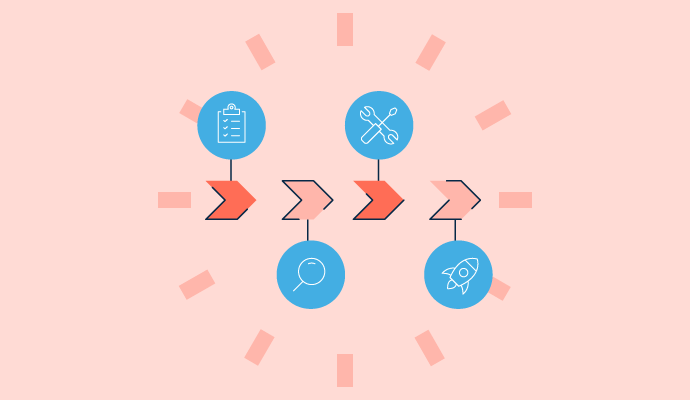What is process management?
Process management is an approach to analyzing and optimizing a business’s systems and workflows. Also known as business process management (BPM), the discipline helps increase productivity in day-to-day operations and clarify goals and outcomes.
Companies use process management to streamline different aspects of their systems depending on whether they need help managing documents, employees, or technology. BPM takes months of planning and implementation to do well, but it has long-lasting positive effects on a company’s efficiency and profitability.
Business process management software is designed to help organizations capture and automate complex processes. For increased functionality, most BPM tools offer integrations with other software, such as customer relationship management (CRM).
Types of process management
While process management is useful in small businesses, it excels in helping mid-to-large businesses run with agility. Organizations can choose from three types of BPM to suit their needs.
- Human-centric: Some tasks and processes need a human touch. Human-centric BPM creates easy-to-use interfaces to ensure compliance. It allows for notifications, alerts, and automation for repeatable tasks. Collaboration between co-workers becomes easier and flows better, reducing preventable errors.
- Integration-centric: Sometimes known as systems-centric, this type optimizes technological processes so they can run with minimal human interference. Application programming interfaces (APIs) and connectors integrate organizations’ existing CRMs with other solutions.
- Document-centric: This approach simplifies the process of moving contracts or reports through multiple stages, parties, or departments. Sometimes BPM tools offer a general arsenal of routing documents and notifying parties. Other times, they specialize in a single task, such as signature acquisition or verification.
Stages of process management
The business process management lifecycle typically has five phases. However, every project is unique. Some may experience extra stages or move back and forth between phases.
- Design: After analyzing the existing process, the company designs a new workflow to resolve issues and add efficiency. If necessary, multiple design iterations are created to provide options to stakeholders.
- Model: At this step, a business generates a visual model of the workflow, taking the process from start to the desired outcome. The company looks at how data might wind its way through the system and tests with sample data and scenarios to ensure the model works.
- Execute: Here, the new process is implemented. An organization might consider starting with a small pilot group first. Employees must receive ample training and support at this phase.
- Monitor: Companies track key performance indicators (KPIs) and user feedback to ensure progress.
- Optimize: Based on feedback and data, businesses continue to make adjustments to the process. Even slight modifications bring workflows closer to peak performance.
Benefits of process management
Companies often have hundreds or thousands of processes running on a daily basis – from using onboarding software to bring on new employees to filling orders to running contracts through the appropriate teams. Tightening up these processes through BPM can help:
- Improve work quality. By reducing opportunities for error in their processes, a business creates better products and services for clients.
- Increase efficiency. The BPM lifecycle includes stages for monitoring and optimizing, meaning that a process is continually made more efficient. Plus, BPM uses automation whenever possible to save employees time.
- Promote visibility. With process management software, companies have access to analytics to observe performance. Managers and executives can see where processes are flowing smoothly and where they are meeting resistance.
Process management best practices
Business process management can be a time-consuming process that requires cooperation across departments. However, the approach reaps many rewards for companies when they concentrate on these elements.
- Analysis of current processes: A business must understand the intricate details of its existing processes before making adjustments of any kind. Managers can talk to employees who have personal experience with a workflow, noting what works and what doesn’t. Some processes may just need adjustments instead of a complete overhaul.
- Communication with stakeholders: A crucial part of BPM implementation involves asking questions of everyone affected by the process: customers, buyers, suppliers, and employees. Then, the company can consider how to balance the preferences of key groups.
- Employee involvement: BPM is about making changes to existing ways of working. To make these changes easier for employees, organizations should encourage a growth mindset culture. All employees need the opportunity to ask questions at company meetings without judgment.
- Small steps toward change: Once staff members are on board, managers should introduce new workflows slowly. For example, a company could start by tackling smaller, less complex processes or by tackling larger, more complex issues in stages. In this way, employees are less likely to get overwhelmed and give up on new protocols entirely.
- The right tool: Software plays an important role in the success of a BPM program. A variety of products are available to help solve human-centric, document-centric, and integration-centric workflow issues. A company should consider features, integration capabilities, and budget before deciding on the best fit.

Kelly Fiorini
Kelly Fiorini is a freelance writer for G2. After ten years as a teacher, Kelly now creates content for mostly B2B SaaS clients. In her free time, she’s usually reading, spilling coffee, walking her dogs, and trying to keep her plants alive. Kelly received her Bachelor of Arts in English from the University of Notre Dame and her Master of Arts in Teaching from the University of Louisville.




















